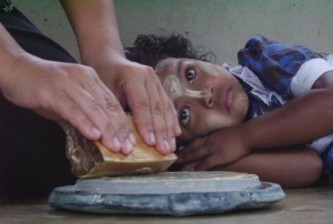Migration and girls’ education: Looking beyond economics
Sarah McLeish, ILO Regional Office for Asia and the Pacific
Across the Asia-Pacific region, millions of men and women migrate every year and a significant number leave behind dependent children, often in the care of grandparents or other relatives. Although researchers and policymakers have tended to focus on international migrants, it is clear that the vast majority of this migration is internal and takes place within the boundaries of nation states.

In Thailand, a girl rests on the ground beside her teacher in a nursery for children from Myanmar. Photo credit: UNICEF/NYHQ2006-1787/Maw
From an economic perspective, both internal and international migration can have a significant positive impact on education, since remittances from migrant workers make households less reliant on the incomes they can gain by sending child ren to work, enabling children to stay in school for longer.
At the same time, by boosting government revenues, money earned or sent home by migrant workers can help to fund public investments in education.Recent research by the ILO has underlined the importance of looking beyond this purely economic standpoint to consider the more nuanced impacts on the children left behind, including the disruptions that can be caused to family dynamics and the emotional turmoil that can result from a parent’s absence. In particular, this research has shown that:
- Younger children of migrant mothers often lag behind their classmates in terms of academic achievement.
- Girls who are left behind when their mothers migrate often have to take over domestic chores and the burden of housekeeping and caring duties; negatively affecting their school attendance.
- Children left behind can suffer emotional problems, making them more likely to abandon school and more likely to have problems with authority and drug abuse.
That is why it is important to focus on some of the less tangible impacts of migration on girls’ education–to look at what children attain at school, rather than just their attendance; how family dynamics shift when parents migrate; and the emotional consequences this can bring about.
These insights have fed into ILO programmes in the region, including the CP-TING project which worked with the All China Women’s Federation to provide life skills training to girls whose parents had migrated. This approach was successful in reducing the drop-out rate for left-behind children through improved attitudes to schooling and greater value being placed on staying in school.
For further information or to access the report visit: www.ilo.org/ipec/areas/Migration_and_CL/lang--en/index.htm
Edited by Jessica Aumann